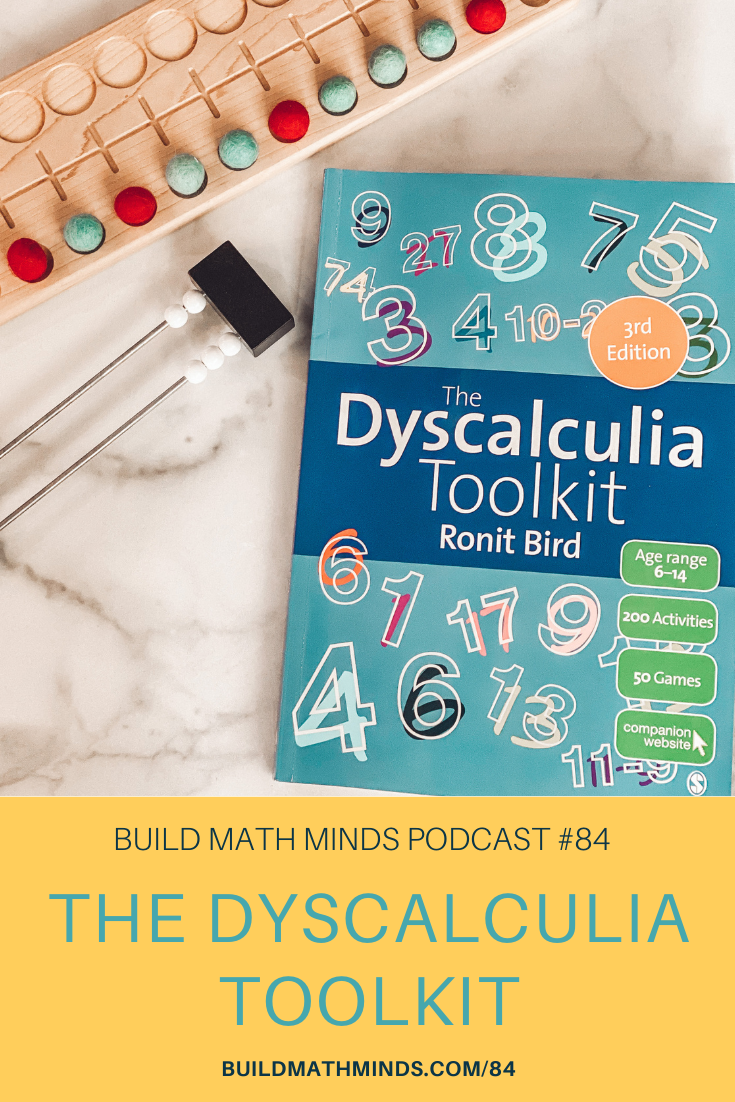Resources mentioned in this episode:
Ronit Bird’s website
The Dyscalculia Toolkit by Ronit Bird (use code MATHSHIP for free shipping)
Become a member of the Build Math Minds PD site
Welcome fellow Recovering Traditionalists to Episode 84. Today we are looking at The Dyscalculia Toolkit.
When educators started hearing about dyscalculia (Dis-cal-coo-lia), it was often misunderstood. People thought it was like dyslexia but with numbers…so they assumed that it meant kids just switched around numerals, but that’s not what dyscalculia is.
On page 5 of The Dyscalculia Toolkit, Ronit (Raw-nit) Bird writes:
“Developmental dyscalculia was first recognised in the UK by the Department of Education and Science in 2001 and defined as: ‘a condition that affects the ability to acquire arithmetical skills. Dyscalculic learners may have difficulty understanding simple number concepts, lack an intuitive grasp of numbers, and have problems learning number facts and procedures. Even if they produce a correct answer or use a correct method, they may do so mechanically and without confidence’ (DfES 0512/2001, p.2).”
Now I know that may sound like a whole lot of your students, depending upon the day. The research around dyscalculia is still so new and in the book she says that estimates say around 4-6% of the population have dyscalculia, which equates to around 1 child in an average classroom.
To help you a bit more to decide if a struggling kiddo has dyscalculia, later on page 5 she lists out these indicators for dyscalculia:
- an inability to subitise (see without counting) even very small quantities
- an inability to estimate whether a numerical answer is reasonable
- weaknesses in both short-term and long-term memory
- an inability to count backwards reliably
- a weakness in visual and spatial orientation
- directional (left/right) confusion
- slow processing speeds when engaged in maths activities
- trouble with sequencing
- a tendency not to notice patterns
- a problem with all aspects of money
- a marked delay in learning to read a clock to tell the time
- an inability to manage time in daily life.
If you have kiddos who have these indicators, it’s worth digging into more to see if you can get testing done to officially diagnose it.
In the book, Ronit discusses the type of teaching that dyscalculic learners need. In short, these kiddos need concrete materials and visual models. She goes into detail about it throughout the book along with the other suggestions on how best to help kiddos with dyscalculia.
The book is full of activities and games so you have lots of practical ideas that you can use as soon as you open the book. If you have a kiddo in your life or in your classroom who has those indicators I highly suggest you get the book to give you ideas on how to help, even if the child doesn’t get an official diagnosis, because all the things mentioned in this book are great teaching practices for all our learners.
Subscribe and Review in iTunes
Hey, are you subscribed to the Build Math Minds Podcast, yet? If you’re not, make sure to do that today because I don’t want you to miss any episodes! Click here to subscribe to the podcast in iTunes.
While you’re there, don’t forget to leave a review on iTunes too. I would love to know your thoughts and how we can make sure that we give you content that you will really enjoy.
To leave a review, head over to iTunes and click on “Ratings and Reviews” and “Write a Review.” I can’t wait to hear your thoughts about the podcast.




